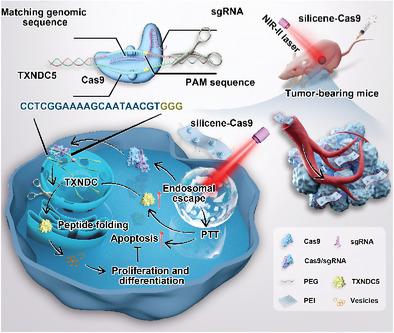当前位置:
X-MOL 学术
›
Adv. Funct. Mater.
›
论文详情
Our official English website, www.x-mol.net, welcomes your
feedback! (Note: you will need to create a separate account there.)
CRISPR/Cas9-2D Silicene Gene-Editing Nanosystem for Remote NIR-II-Induced Tumor Microenvironment Reprogramming and Augmented Photonic Tumor Ablation
Advanced Functional Materials ( IF 18.5 ) Pub Date : 2021-09-12 , DOI: 10.1002/adfm.202107093 Haohao Yin 1, 2, 3, 4 , Bangguo Zhou 1, 2, 3, 4 , Caihong Dong 5 , Yan Zhang 1, 2, 3, 4 , Jifeng Yu 1, 2, 3, 4 , Yinying Pu 1, 2, 3, 4 , Wei Feng 6 , Liping Sun 1, 2, 3, 4 , Hui Hu 7 , Yu Chen 6 , Huixiong Xu 1, 2, 3, 4
Advanced Functional Materials ( IF 18.5 ) Pub Date : 2021-09-12 , DOI: 10.1002/adfm.202107093 Haohao Yin 1, 2, 3, 4 , Bangguo Zhou 1, 2, 3, 4 , Caihong Dong 5 , Yan Zhang 1, 2, 3, 4 , Jifeng Yu 1, 2, 3, 4 , Yinying Pu 1, 2, 3, 4 , Wei Feng 6 , Liping Sun 1, 2, 3, 4 , Hui Hu 7 , Yu Chen 6 , Huixiong Xu 1, 2, 3, 4
Affiliation

|
Photothermal therapy (PTT) is a minimally invasive and highly specific antineoplastic treatment, whereas the significant upregulation of TXNDC5 gene expression following PTT cripples the photothermal ablation efficacy through protein processing in the endoplasmic reticulum signaling pathway, as transcriptome sequencing and bioinformatics analysis revealed in this research. To tackle this crucial issue, a second near-infrared biowindow (NIR-II) light-controlled CRISPR/Cas9 nanosystem (silicene-Cas9) is constructed based on biosafe and biodegradable 2D silicene nanosheets with desirable photothermal-conversion capability. The elaborate system enables remote NIR-II-induced reprogramming of tumor microenvironment for enhanced photonic tumor ablation. Moreover, this CRISPR/Cas9 delivery system is carried out to precisely and efficiently knock down TXNDC5 for reprogramming the tumor microenvironment and amplifying the photothermal performance of silicene, exhibiting high efficiency and controlled gene-editing capacity of 47.68% and significantly improving therapeutic effect of tumor ablation without recurrence both in vitro and in vivo. This work not only provides a paradigm of improving the effectiveness of photothermal tumor therapy, but also develops a safe and efficient 2D silicene-based nonviral vector for harnessing CRISPSR/Cas9 technology-mediated genome editing, which further broadens the biomedical application of 2D silicene nanosheets.
中文翻译:

用于远程 NIR-II 诱导的肿瘤微环境重编程和增强光子肿瘤消融的 CRISPR/Cas9-2D 硅烯基因编辑纳米系统
光热疗法 (PTT) 是一种微创且高度特异性的抗肿瘤治疗,而本研究揭示的转录组测序和生物信息学分析表明,PTT 后 TXNDC5 基因表达的显着上调通过内质网信号通路中的蛋白质加工削弱了光热消融功效. 为了解决这个关键问题,基于具有理想光热转换能力的生物安全和可生物降解的二维硅烯纳米片构建了第二个近红外生物窗(NIR-II)光控 CRISPR/Cas9 纳米系统(硅烯-Cas9)。精心设计的系统能够实现远程 NIR-II 诱导的肿瘤微环境重编程,以增强光子肿瘤消融。而且,该CRISPR/Cas9递送系统用于精确高效地敲低TXNDC5以重编程肿瘤微环境并放大硅烯的光热性能,表现出高效率和47.68%的可控基因编辑能力,显着提高肿瘤消融的治疗效果,无需体外和体内复发。这项工作不仅为提高光热肿瘤治疗的有效性提供了范例,而且开发了一种安全有效的基于二维硅烯的非病毒载体,用于利用 CRISPSR/Cas9 技术介导的基因组编辑,进一步拓宽了二维硅烯纳米片的生物医学应用. 表现出47.68%的高效和可控基因编辑能力,显着提高了肿瘤消融的治疗效果,体内外均无复发。这项工作不仅为提高光热肿瘤治疗的有效性提供了范例,而且开发了一种安全有效的基于二维硅烯的非病毒载体,用于利用 CRISPSR/Cas9 技术介导的基因组编辑,进一步拓宽了二维硅烯纳米片的生物医学应用. 表现出47.68%的高效和可控基因编辑能力,显着提高了肿瘤消融的治疗效果,体内外均无复发。这项工作不仅为提高光热肿瘤治疗的有效性提供了范例,而且开发了一种安全有效的基于二维硅烯的非病毒载体,用于利用 CRISPSR/Cas9 技术介导的基因组编辑,进一步拓宽了二维硅烯纳米片的生物医学应用.
更新日期:2021-09-12
中文翻译:

用于远程 NIR-II 诱导的肿瘤微环境重编程和增强光子肿瘤消融的 CRISPR/Cas9-2D 硅烯基因编辑纳米系统
光热疗法 (PTT) 是一种微创且高度特异性的抗肿瘤治疗,而本研究揭示的转录组测序和生物信息学分析表明,PTT 后 TXNDC5 基因表达的显着上调通过内质网信号通路中的蛋白质加工削弱了光热消融功效. 为了解决这个关键问题,基于具有理想光热转换能力的生物安全和可生物降解的二维硅烯纳米片构建了第二个近红外生物窗(NIR-II)光控 CRISPR/Cas9 纳米系统(硅烯-Cas9)。精心设计的系统能够实现远程 NIR-II 诱导的肿瘤微环境重编程,以增强光子肿瘤消融。而且,该CRISPR/Cas9递送系统用于精确高效地敲低TXNDC5以重编程肿瘤微环境并放大硅烯的光热性能,表现出高效率和47.68%的可控基因编辑能力,显着提高肿瘤消融的治疗效果,无需体外和体内复发。这项工作不仅为提高光热肿瘤治疗的有效性提供了范例,而且开发了一种安全有效的基于二维硅烯的非病毒载体,用于利用 CRISPSR/Cas9 技术介导的基因组编辑,进一步拓宽了二维硅烯纳米片的生物医学应用. 表现出47.68%的高效和可控基因编辑能力,显着提高了肿瘤消融的治疗效果,体内外均无复发。这项工作不仅为提高光热肿瘤治疗的有效性提供了范例,而且开发了一种安全有效的基于二维硅烯的非病毒载体,用于利用 CRISPSR/Cas9 技术介导的基因组编辑,进一步拓宽了二维硅烯纳米片的生物医学应用. 表现出47.68%的高效和可控基因编辑能力,显着提高了肿瘤消融的治疗效果,体内外均无复发。这项工作不仅为提高光热肿瘤治疗的有效性提供了范例,而且开发了一种安全有效的基于二维硅烯的非病毒载体,用于利用 CRISPSR/Cas9 技术介导的基因组编辑,进一步拓宽了二维硅烯纳米片的生物医学应用.











































 京公网安备 11010802027423号
京公网安备 11010802027423号